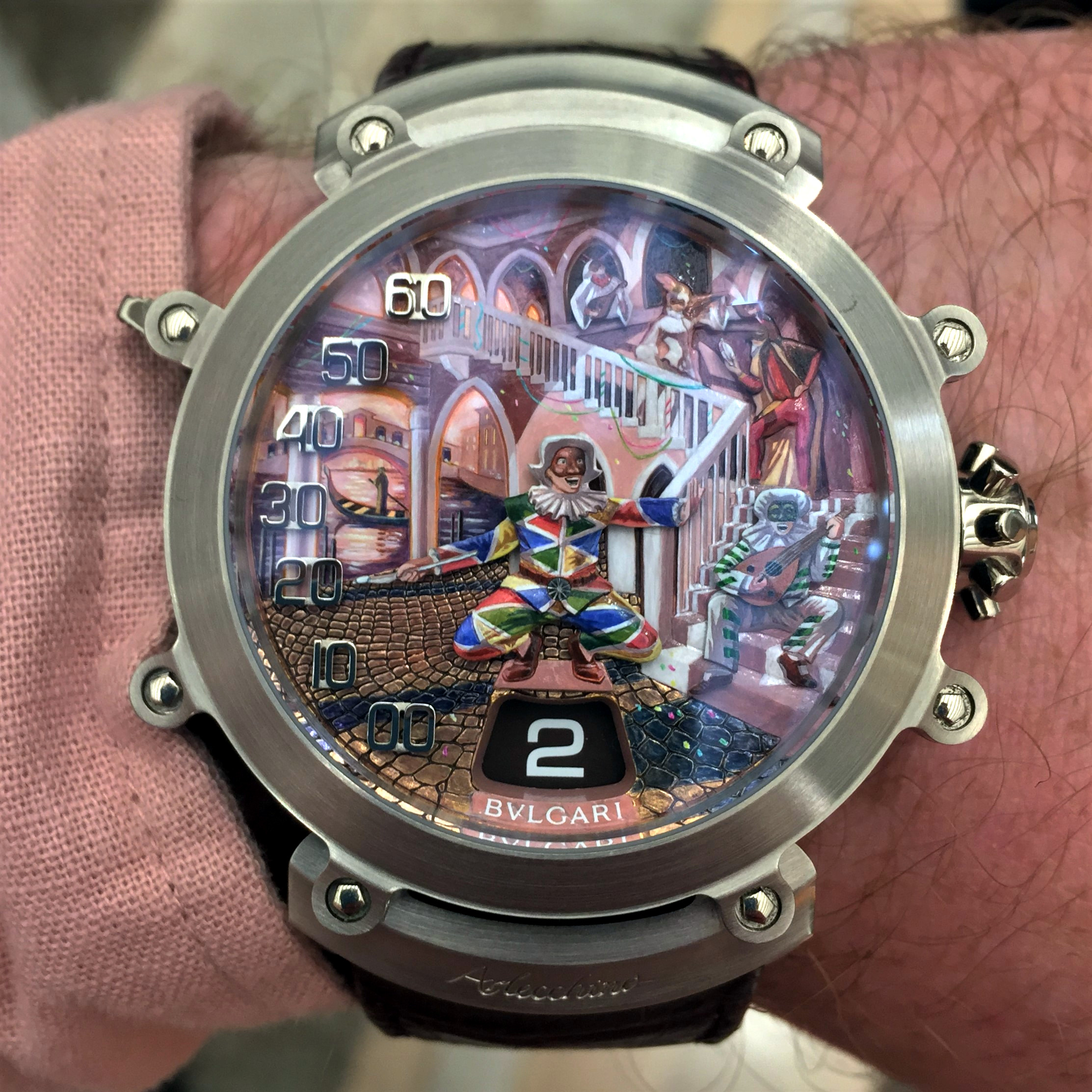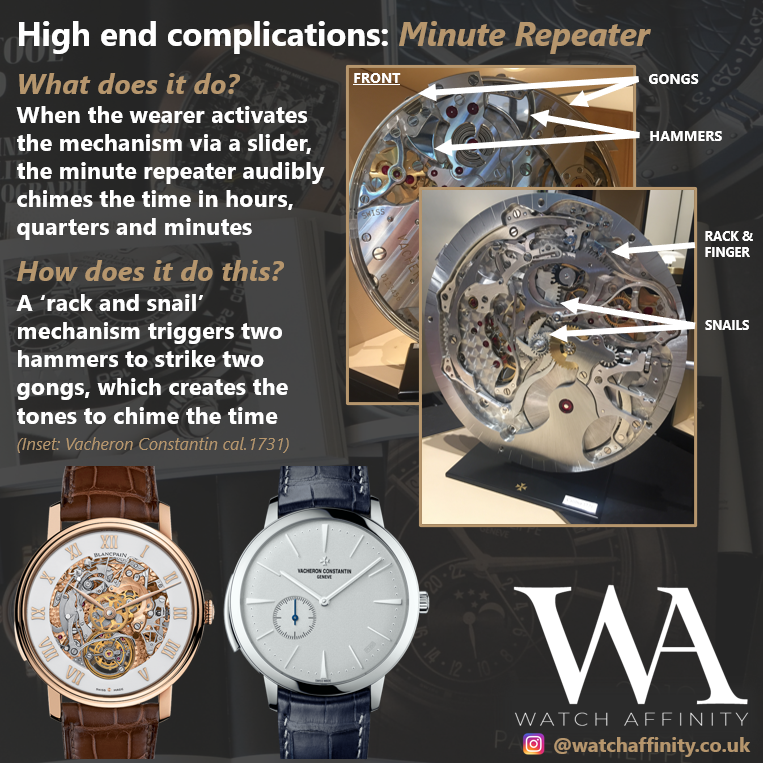In the previous two parts of our “It’s Complicated” series, we first looked at the tourbillon and then the perpetual calendar. In this, the third and final (at least for now!) part of our “It’s Complicated” series, we take a look at perhaps the most complicated of them all – the minute repeater…
The Minute Repeater
My personal favourite complication, the minute repeater, is a particular type of striking watch with an acoustic complication whereby a timepiece is able to audibly chime out the current time, owing to a mechanism in the calibre. Depending on the complexity of the striking mechanism (we will cover these in a moment), the complication will chime out firstly the number of hours, followed by the number of quarter-hours, and finally the additional minutes.
There are differing degrees of striking mechanisms which are available, including half-quarter and quarter, 5 minute, and minute repeaters. Additionally, there are two distinct families in repeater complications and sonneries. What differentiates these is that a sonnerie complication requires no involvement from the wearer to instigate the striking mechanism, whereas a repeater does.
A grande sonnerie automatically chimes the number of hours every hour, and then both the hour and quarters every 15 minutes, whereas the petite sonnerie chimes the hour every hour, and only the quarters every 15 minutes.
A repeater complication is one where this audible chiming of the time is instigated by the wearer, normally via a push piece or a slider on the side of the case – indeed as such mechanisms are internal with no ‘display’ to speak of, this slider can often be the only indication of such a complication and easily go unnoticed.
For both a sonnerie and a repeater, the sound is achieved by the mechanism triggering two hammers to strike two respective gongs within the timepiece, which each produce different tones.

Bvlgari Commedia Dell'Arte minute repeater with jumping hour and retrograde minutes
The hours are usually chimed by a lower pitch tone, which we will call ‘dong’. The additional minutes are a higher pitch tone, which we will call ‘ding’. The quarters are denoted by combining the two, for a ‘ding-dong’ sound. So, an example time of 3:51 would be chimed by three ‘dongs’, a further three ‘ding-dongs’ as three quarter-hours have elapsed, and a final six ‘dings’ to count from 45 to 51 minutes.
(Just to complicate things, most modern sonnerie watches come with a repeater mechanism so that the wearer can disable the automatic chiming of the timepiece every 15 minutes where it might be unwanted, such as at night-time).
When you take a step back and consider that the minute repeater as a mechanism affords the wearer the opportunity to, on demand, instigate the timepiece to chime out the current time down to the minute, you realise just how remarkable this actually is. However, when you learn that the first minute repeating pocket watch was in fact made in 1750, I find it then becomes even more awe-inspiring.
How exactly does one go about creating a mechanism which is capable not only of keeping accurate time, but also including the capability of chiming out the time down to the minute – and fit all this into a humble wristwatch? The striking mechanism within repeater and sonnerie wristwatches is based on something called a ‘rack and snail’, a mechanism created by Reverend Edward Barlow in 1676 for the repeating clock.
For the minute repeater, this portion of the mechanism is essentially led by the traditional hours and minutes functions. The part of the repeater mechanism which then stores this information is called the snail, and there is a snail for the hours, quarters and minutes. As time progresses, the information is stored in this trio of snails with support from the racks, which then remain poised to chime the time whenever initiated to do so by the wearer. When the push piece or slider is activated, the time information stored is then ‘released’, and the mechanism triggers the gongs to sound out the time – magic!
In order to transmit this information to the hammers and gongs, the mechanism uses a set of racks, levers and cams. Each rack is connected to the snail by a ‘finger’, which as the time advances will move along the teeth on the rack, allowing a different amount of lateral movement of the rack when the mechanism is activated. You can think of this as almost pointing to the time.
For instance, the hour snail has twelve teeth, so at 12 o’clock the finger will be ‘pointing’ such that the hammer will strike the gong 12 times. At 4 o’clock, the finger will ‘point’ to only allow enough lateral movement in the rack for the hammer to strike the gong 4 times. For the quarter snail, the hammer will only strike the gong after 15 minutes of the hour have elapsed and the finger is set for one chime. The minute rack only has 14 teeth, because the 15th minute of the quarter is instigated by the quarter snail.
After the time is sounded, each rack can reset itself without setting the hammers to strike the gongs as they are only engaged as the rack passes in one direction. As the racks reset their positions, they do so silently.
These mechanisms which facilitate these complications can contain over 100 individual components alone, and so it is easy to see why the minute repeater is perhaps the most technically difficult complications to assemble.
I can still remember the first time I heard a minute repeater chime the time, and that the sense of awe I experienced is something I will not forget for a long time. If you ever find yourself in a boutique or retailer with a minute repeater timepiece, I cannot recommend strongly enough that you ask to hear one in action – I’m sure the attendant will be only too happy to oblige!
The minute repeater would surely be the jewel in the crown of any watch collection. To try and better illustrate the complexity, we have created an infographic to try and point out some of the key components we’ve discussed on a scale model of Vacheron Constantin’s calibre 1731:

In summary
Beyond even the complications we have covered in this series, there are of course many more that exist, from high-end grand complication pieces which combine a multitude of specific and high-end complications into a single piece, astronomical complications such as the terrarium, and other acoustic complications, through to the more widely accessible complications such as chronographs, moon-phases and mechanical alarms. Hublot have even released a complication enabling you to keep score whilst playing golf!
This plethora of choice is of course thanks to the great watchmakers of the world who continue to push the boundaries of horology ever further – who knows what we will see in the future…
We really hope that you have found this series of articles informative and helpful – please get in touch and let us know what you think via our Contact page, or via our Instagram.
You might also be interested in:
- “It’s complicated” Part 1: an introduction to the Tourbillon
- “It’s complicated” Part 2: an introduction to the Perpetual Calendar
- “It’s complicated”: Resonance in watchmaking
- Watch Stationery and Gift Ideas
- Watch Books, Watch Boxes and more at the Watch Affinity Shop on Amazon (commissions earned)
As an Amazon Associate, I earn from qualifying purchases – thank you for your support

